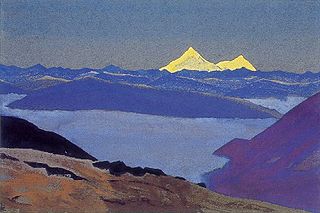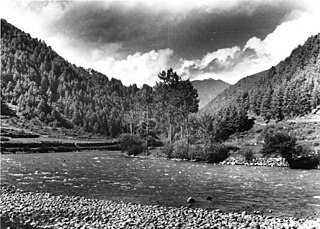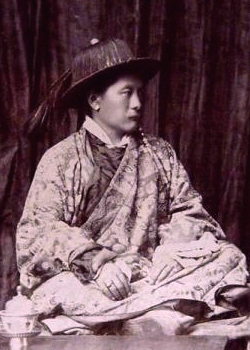Related Research Articles

Sikkim is a state in northeastern India. It borders the Tibet Autonomous Region of China in the north and northeast, Bhutan in the east, Koshi Province of Nepal in the west, and West Bengal in the south. Sikkim is also close to the Siliguri Corridor, which borders Bangladesh. Sikkim is the least populous and second smallest among the Indian states. Situated in the Eastern Himalaya, Sikkim is notable for its biodiversity, including alpine and subtropical climates, as well as being a host to Kangchenjunga, the highest peak in India and third highest on Earth. Sikkim's capital and largest city is Gangtok. Almost 35% of the state is covered by Khangchendzonga National Park – a UNESCO World Heritage Site.

Tashi Namgyal was the ruling Chogyal (King) of Sikkim from 1914 to 1963. He was the son of Thutob Namgyal. He was the first independent king of Sikkim.

The Lepcha are among the indigenous peoples of the Indian state of Sikkim and Nepal, and number around 80,000. Many Lepcha are also found in western and southwestern Bhutan, Tibet, Darjeeling, the Koshi Province of eastern Nepal, and in the hills of West Bengal. The Lepcha people are composed of four main distinct communities: the Renjóngmú of Sikkim; the Dámsángmú of Kalimpong, Kurseong, and Mirik; the ʔilámmú of Ilam District, Nepal; and the Promú of Samtse and Chukha in southwestern Bhutan.

Jelep La elevation 14,390 feet (4,390 m), is a high mountain pass between Sikkim, India and Tibet Autonomous Region, China. It is on a route that connects Lhasa to India. The pass is about 4 km (2.5 mi) south of Nathu La and is slightly higher. It was frequently used for trade between Tibet and India during the British Raj, with Kalimpong serving as the contact point. The Menmecho Lake lies below the Jelep La.

The Chogyal were the monarchs of the former Kingdom of Sikkim, which belonged to the Namgyal dynasty. The Chogyal was the absolute monarch of Sikkim from 1642 to 1973, and the constitutional monarch from 1973 to 1975, when the monarchy was abolished and the Sikkimese people voted in a referendum to make Sikkim the 22nd state of India.

The history of Sikkim begins with the indigenous Lepcha's contact with early Tibetan settlers. Historically, Sikkim was a sovereign Monarchical State in the eastern Himalayas. Later a protectorate of India followed by a merger with India and official recognition as a state of India. Lepchas were the main inhabitants as well as the Ruler of the land up to 1641. Lepchas are generally considered to be the first people, indigenous to Sikkim also includes Darjeeling.

Yuksom is a historical town in Geyzing subdivision of West Sikkim district in the Northeast Indian state of Sikkim. It was the first capital of Kingdom of Sikkim established in 1642 AD by Phuntsog Namgyal who was the first Chogyal of Sikkim. The coronation site of the first monarch of Sikkim is known as the "Throne of Norbugang". Yuksom is where there is the Norbugang Chorten near the Norbugang throne, the place Namgyal was crowned and several monasteries and a lake. The dynastic rule of the Chogyals lasted for 333 years.

Phuntsog Namgyal (1604–1670) was the first Chogyal (monarch) of Sikkim, now an Indian state. He consecrated in 1642 at the age of 38. Phuntsog was a fifth generation descendant of Khye Bumsa, a 13th-century prince from the Mi-nyak House in Kham in Eastern Tibet. According to legend, Guru Rinpoche, a 9th-century Buddhist saint had foretold the event that a Phuntsog from the east would be the next chogyal of Sikkim. In 1642, three lamas, from the north, west, and south went in search for the chosen person. Near present-day Gangtok, they found a man churning milk. He offered them some refreshments and gave them shelter. So impressed were they by his deeds that they realised that he was a chosen one and immediately crowned him king. The crowning took place Norbughang near Yuksom on a stone slab in a pine covered hill, and he was anointed by sprinkling water from a sacred urn.

The Chumbi Valley, called Dromo or Tromo in Tibetan, is a valley in the Himalayas that projects southwards from the Tibetan plateau, intervening between Sikkim and Bhutan. It is coextensive with the administrative unit Yadong County in the Tibet Autonomous Region of China. The Chumbi Valley is connected to Sikkim to the southwest via the mountain passes of Nathu La and Jelep La.

Tashi Namgyal Academy (TNA) is a public school in the Himalayan state of Sikkim in India. It was founded in 1926 by the late Sir Tashi Namgyal, KCSI, KCIE, the 11th consecrated Ruler of Sikkim. It is an autonomous English-medium, co-educational and residential-cum-day school.

Thutob Namgyal was the ruling chogyal (monarch) of Sikkim between 1874 and 1914. Thutob ascended to the throne succeeding his half-brother Sidkeong Namgyal who died issueless. Differences between the Nepalese settlers and the indigenous population during his reign led to the direct intervention of the British, who were the de facto rulers of the Himalayan nation. The British ruled in favour of the Nepalese much to the discontent of the chogyal, who then retreated to the Chumbi Valley and allied himself with the Tibetans.

The History of Darjeeling covers the history of Darjeeling town and its adjoining hill areas belonging to Sikkim, but eventually part of British India so now in the Indian state of West Bengal, which is intertwined with the history of Nepal, Sikkim, Bhutan, Bengal and Great Britain. Part of the state of Sikkim, Darjeeling became part of an important buffer state between Nepal and Bhutan. The British, using the area as a sanitorium, found that the climate provided excellent tea-cultivating conditions and soon began to grow tea on the hills of Darjeeling. Darjeeling tea remains a world-renowned export from Darjeeling.

Yatung or Yadong, also known as Shasima , is the principal town in the Chumbi Valley or Yadong County in the Tibet Autonomous Region of China. It is also its administrative headquarters.

Sidkeong Tulku Namgyal was the ruling Maharaja and Chogyal of Sikkim for a brief period in 1914, from 10 February to 5 December.
The indigenous people of Sikkim are the Lepchas; the naturalized ethnic populations of Limbus, Bhutias, Kiratis, Indian Gorkhas or Indian Nepali/Nepalese who have an enduring presence in shaping the history of modern Sikkim. The indigeneity criteria for including all peoples of Sikkim and Darjeeling hills is a misnomer as it is clearly known that Lepchas are the first people who trace their origin and culture of their ethnogenesis to the historical and somewhat political geography of Sikkim history as is well documented by colonial and immigrant settler history. However many tribes preceded the migration of the colonial powers and can trace their migratory background as well as ancestral heritage and a well formed history of civilization and cultural locus that is not inherently indigenous to Sikkim.

Tashiding Monastery is a Buddhist monastery of the Nyingma sect of Tibetan Buddhism in Western Sikkim, northeastern India, which is the most sacred and holiest monasteries in Sikkim. It is described as the "Heart of Sikkim/Denzong", citing to its importance of religious sacredness. It is located on top of the hill rising between the Rathong chu and the Rangeet River, 40 kilometres (25 mi) from Gyalshing and 19 kilometres (12 mi) to the south east of Yuksam. The annual festival of Bumchu, meaning ~Holy water~ takes place on the 14th and 15th of the 1st month of Tibetan lunar calendar, often around the months of February and March. The festival is believed to predict the upcoming forecasts and events for Sikkim in the coming year. Undoubtedly, one of the most important and holiest festivals for all the Buddhists in Sikkim and around, it also provides for a perfect platform for all those Non-Buddhists who seek a deeper insight into Buddhism and its religious customs, beliefs and rituals. History of the Festival- Somewhere between 755 and 804 CE in Tibet under the reign of King Trisong Deutsen. It was under his rule that Guru Padmasambhava when invited to Tibet performed a holy sadhana and consecrated the land with water from his SACRED VASE, which was then later concealed as a hidden treasure in his most blessed place, the Tashiding Monastery in Sikkim. Somewhere around 17th century, the vase was again discovered by one of the reincarnations of Padmasambhava and it is since that time, this festival again resumed with all its glory and splendour in the hidden and blessed land of Sikkim/Beyul Demozong. Tashiding is the nearest town to the Tashiding Monastery (Gompa)

Kabi Lungchok is a historic site of significance, which is located 17 kilometres (11 mi) north of Gangtok on the Northern Highway in northeastern Indian state of Sikkim. The historicity of the site is attributed to the fact that the Lepchas, the ethnic tribals of Sikkim and Bhutias, the immigrants from southern Bhot who settled down in Sikkim from the 14th century onwards, ceremonially signed a "Treaty of Blood Brotherhood" with religious fervour. Stone pillars mark the location where the treaty was signed. The Treaty was signed at Kabi Lungchok by the Bhot King, Khye Bumsa representing the Bhutias and the Lepcha Chief Thekong Tek. The literal meaning of 'Kabi Lungchok', pronounced ‘Kayu sha bhi Lungchok’, is "stone erected by our blood." Life-size statues of the Lepcha and Bhutia 'blood-brothers' who signed the treaty has been erected here.

Ging Gompa is a Buddhist monastery in Darjeeling, West Bengal, India. The monastery is located in Ging, about 10 km (6.2 mi) from Darjeeling. It is one of the oldest monasteries in Darjeeling and subscribes to the Nyingmapa tradition of Tibetan Buddhism. On historical grounds, the monastery is still under the administrative control of the Government of Sikkim.

Chumbi is a historic village in the Chumbi Valley or the Yadong County of the Tibet Autonomous Region of China. It is in the valley of Amo Chu river, where the route from Sikkim's Cho La pass meets the Amo Chu valley. The "Chumbi Valley" of the European nomenclature derives its name from the village of Chumbi. It was the administrative center of the lower Chumbi Valley until the Chinese take-over of Tibet in 1950, after which Yatung became its headquarters. Chumbi is also associated with the Sikkim's royal family, which had a summer palace in the village.
Gaeboo Achyok or Gyalpo Ajok was a Lepcha chieftain of a principality based at Damsang, presently in the Kalimpong district of West Bengal, India.
References
- ↑ Mullard 2011, p. 38.
- ↑ Datta-Ray, Sunanda K. (1984). Smash and grab: annexation of Sikkim. New Delhi: Vikas. p. 17. ISBN 0-7069-2509-2. OCLC 12106123.
- ↑ Basnet, Lal Bahadur (1974). Sikkim: A Short Political History. New Delhi: S. Chand Group. p. 13. OCLC 994925.
- 1 2 Mullard 2011, pp. 39–40.
- ↑ Mullard 2011, p. 40, note 25.
- ↑ Mullard 2011, pp. 40–41.
- ↑ Steinmann 2003–2004, pp. 152–153.
- ↑ Mullard 2011, pp. 41–42.